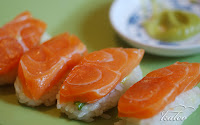
I've had sushi all my life, growing up in Hawaii, where it's a staple. As a kid, I remember being able to get maki rolls and cone sushi (Inari) for 25¢. They weren't fancy, in fact in some instances, the Inari was simply plain sushi rice in the abura age (fried tofu packets). Sushi, was and is pretty common in Hawaii so I never thought much of it , being able to get just about about anywhere.
It really wasn't until I
 moved to New York City with my high school sweetheart that I began to crave sushi, and become aware of the more exclusive nigiri type sushi. For me sushi and Japanese food was about as synonymous with Hawaiian food as I was gonna get in New York. But the 30 years ago, Japanese food in the City was not nearly as prevalent as it is now, and in most major metropolis cities in the U.S. at least.
moved to New York City with my high school sweetheart that I began to crave sushi, and become aware of the more exclusive nigiri type sushi. For me sushi and Japanese food was about as synonymous with Hawaiian food as I was gonna get in New York. But the 30 years ago, Japanese food in the City was not nearly as prevalent as it is now, and in most major metropolis cities in the U.S. at least.  Nigiri sushi is composed of hand formed rice usually with a swab of Wasabi applied to the rice and a piece of "fresh" raw fish laid on top. The variety of nigiri sushi is as wide as the kind of fish available to make it with. Sushi making has been nearly been elevated to a high art form,
Nigiri sushi is composed of hand formed rice usually with a swab of Wasabi applied to the rice and a piece of "fresh" raw fish laid on top. The variety of nigiri sushi is as wide as the kind of fish available to make it with. Sushi making has been nearly been elevated to a high art form,  with practical and talented hands and finger techniques for forming the rice pods or rolling the maki in nori. Apparently sushi chefs spend many years perfecting the finger and hand techniques to properly form sushi rice.
with practical and talented hands and finger techniques for forming the rice pods or rolling the maki in nori. Apparently sushi chefs spend many years perfecting the finger and hand techniques to properly form sushi rice.  One of the popular kinds of sushi I enjoyed as a kid, is the cone sushi or inari sushi which is rice stuffed into a fried tofu pocket. The simplicity of this sushi, with it's sweet taste of the rice with the tofu wrapper is unique and satisfying flavor. In this sample
One of the popular kinds of sushi I enjoyed as a kid, is the cone sushi or inari sushi which is rice stuffed into a fried tofu pocket. The simplicity of this sushi, with it's sweet taste of the rice with the tofu wrapper is unique and satisfying flavor. In this sample  I inserted a a finger full of spicy japanese seaweed (Goma Wakame), and topped it with fine chopped carrots and scallions. Toasted black and white Sesame seeds is also an attractive and tasty garnish.
I inserted a a finger full of spicy japanese seaweed (Goma Wakame), and topped it with fine chopped carrots and scallions. Toasted black and white Sesame seeds is also an attractive and tasty garnish. The Maki rolls are almost equally diverse in kind. Maki rolls use No
 ri, a kind of seaweed made by a shredding and rack-drying process and comes as thin as paper. You place the rice and the fillings on the nori and roll it up using a special bamboo mat made for the job. You could wrap just about anything fresh in the rolls, here I used cucumber, carrots scallions and salmon. I had some yellow pickled radish (Daikon) that I meant to use, but forgot, it's also a popular ingredient in maki rolls.
ri, a kind of seaweed made by a shredding and rack-drying process and comes as thin as paper. You place the rice and the fillings on the nori and roll it up using a special bamboo mat made for the job. You could wrap just about anything fresh in the rolls, here I used cucumber, carrots scallions and salmon. I had some yellow pickled radish (Daikon) that I meant to use, but forgot, it's also a popular ingredient in maki rolls. As the popularity of sushi has grown, so has the innovation in the ingredients and methods. A popular
 new kind of sushi is the California roll which is rolled into a cone sushi using the nori wrap and usually containing a certain amount of avocado and crab meat. In Hawaii, local favorite is known as Musubi, a kinda nigiri using fried spam as the topping. We even have a Philadelphia roll, using... you guessed... Philadelphia cream cheese as a filling ingredient
new kind of sushi is the California roll which is rolled into a cone sushi using the nori wrap and usually containing a certain amount of avocado and crab meat. In Hawaii, local favorite is known as Musubi, a kinda nigiri using fried spam as the topping. We even have a Philadelphia roll, using... you guessed... Philadelphia cream cheese as a filling ingredient For the rice
- 2 cups short/medium grain white rice (I used Nishiki brand) Do not use long grain
- 1/3 cup rice wine vinegar
- 1/3 cup sugar
- 2 tablespoons mirin
- 1/2 teaspoon salt
8 ounces Fresh fish (sushi grade) of your choice 4 crab legs (Kani) or immitation crab meat
3 stalks scallions (green onions)
1 cucumber - julienne
1 large carrot - julienne
1 Avocado - sliced 1 Daikon pickled radish
1 Tablespoon wasabi - more or less to taste
________________________________________________
Sample kinds of fish used for sushi and sashimi
Tuna - Maguro
Salmon - Sake
Yellowtail - Hamachi
Shrimp (cooked) - Ebi
Red Snapper - Ma-Dai
Sea Bass - Suzuki
Mackeral - Saba
Butterfish - Ibo-Dai
Octpuss - Tako
Eel - Unagi
Squid - Ika
________________________________________________


